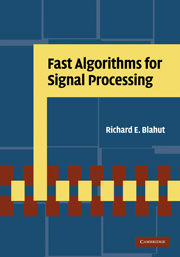Book contents
- Frontmatter
- Contents
- Preface
- Acknowledgments
- 1 Introduction
- 2 Introduction to abstract algebra
- 3 Fast algorithms for the discrete Fourier transform
- 4 Fast algorithms based on doubling strategies
- 5 Fast algorithms for short convolutions
- 6 Architecture of filters and transforms
- 7 Fast algorithms for solving Toeplitz systems
- 8 Fast algorithms for trellis search
- 9 Numbers and fields
- 10 Computation in finite fields and rings
- 11 Fast algorithms and multidimensional convolutions
- 12 Fast algorithms and multidimensional transforms
- A A collection of cyclic convolution algorithms
- B A collection of Winograd small FFT algorithms
- Bibliography
- Index
8 - Fast algorithms for trellis search
Published online by Cambridge University Press: 03 May 2011
- Frontmatter
- Contents
- Preface
- Acknowledgments
- 1 Introduction
- 2 Introduction to abstract algebra
- 3 Fast algorithms for the discrete Fourier transform
- 4 Fast algorithms based on doubling strategies
- 5 Fast algorithms for short convolutions
- 6 Architecture of filters and transforms
- 7 Fast algorithms for solving Toeplitz systems
- 8 Fast algorithms for trellis search
- 9 Numbers and fields
- 10 Computation in finite fields and rings
- 11 Fast algorithms and multidimensional convolutions
- 12 Fast algorithms and multidimensional transforms
- A A collection of cyclic convolution algorithms
- B A collection of Winograd small FFT algorithms
- Bibliography
- Index
Summary
A finite-state machine that puts out n elements from the field F at each time instant will generate a sequence of elements from the field F. The set of all possible output sequences from the finite-state machine can be represented on a kind of graph known as a trellis or, if the number of states is very large, on a kind of graph known as a tree. There are many applications in which such an output sequence from a finite-state machine is observed with errors or in noise, and one must estimate either the output sequence itself or the history of the finite-state machine that generated that sequence. This estimation task is a problem in searching a trellis or a tree for the particular path that best fits a given data sequence. Fast path-finding algorithms are available for such problems. This part of the subject of signal processing is quite different from other parts of signal processing. The trellis searching algorithms, which we introduce in this chapter, are quite different in structure from the other algorithms that we have studied.
Among the applications of trellis-searching and tree-searching algorithms are: the decoding of convolutional codes, demodulation of communication signals in the presence of intersymbol interference, demodulation of partial response waveforms or differential phase-shift-keyed waveforms, text character recognition, and voice recognition.
Trellis and tree searching
A finite-state machine consists of a set of states, a set of transitions between the states, and a set of output symbols from a field F assigned to each transition.
- Type
- Chapter
- Information
- Fast Algorithms for Signal Processing , pp. 262 - 285Publisher: Cambridge University PressPrint publication year: 2010



